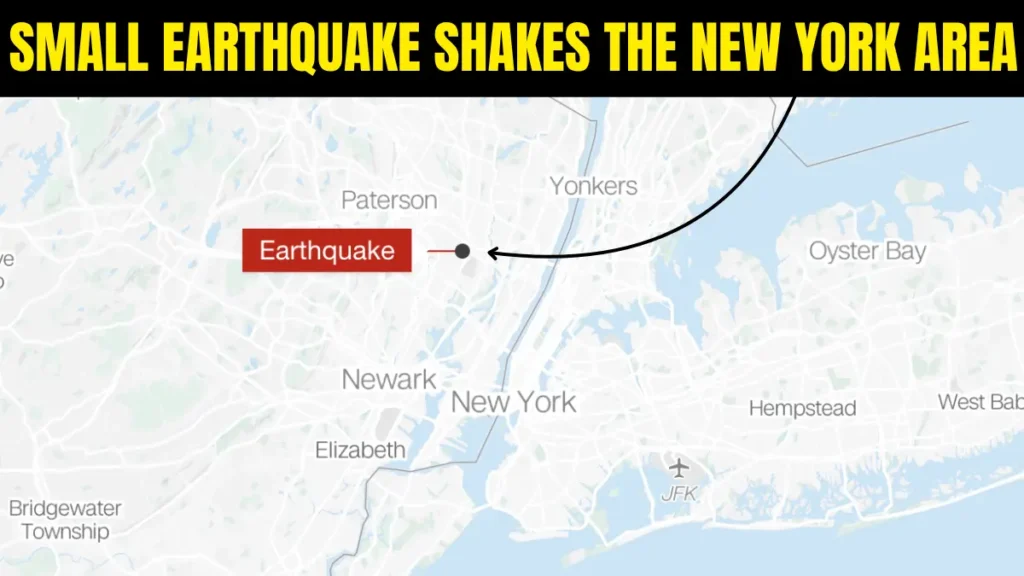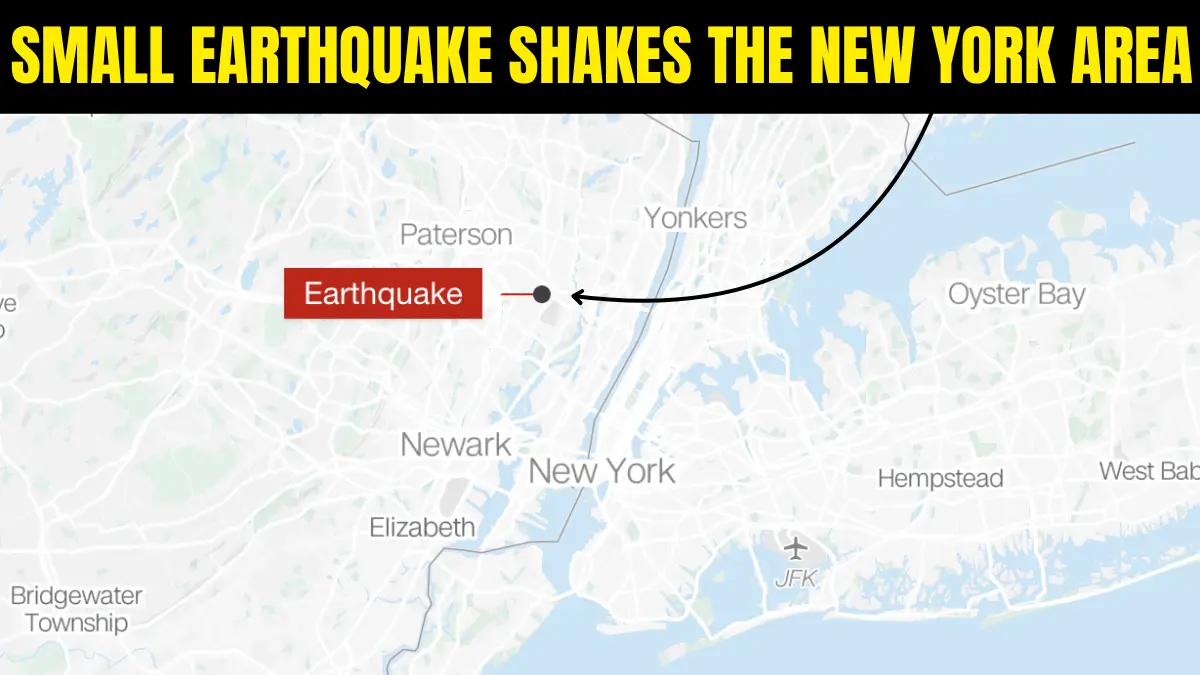A 3.0-magnitude earthquake struck near New York City on Saturday night, causing brief tremors but no major damage. Here’s what we know about the rare seismic event.
Table of Contents
Small Earthquake Shakes the New York Area. USGS Says Magnitude Was 3.0
A Rare Shake for the Northeast
On Saturday night, August 2nd, 2025, the usually stable ground beneath the New York metropolitan area shifted. According to the U.S. Geological Survey (USGS), a magnitude 3.0 earthquake was recorded in Hasbrouck Heights, New Jersey, a suburban town located just 8 miles west of Manhattan’s Central Park. While no significant damage was reported, the tremor set off a wave of reaction across the city that rarely experiences such seismic events.
Epicenter: Hasbrouck Heights, New Jersey
The quake struck at a depth of 6.2 miles, a typical depth for shallow earthquakes that are more easily felt at the surface. While California is no stranger to seismic activity, the Northeast is generally much quieter, which made Saturday night’s tremor an unusual event.
Residents as far as Brooklyn reported feeling a brief shake, which was described as a light swaying motion, lasting only a second or two. “It felt like someone bumped into my apartment building,” said one Brooklyn resident on X (formerly Twitter).
Quick Response, No Major Impacts
New York City Emergency Management issued a statement confirming that there were no immediate reports of injuries or structural damage. Emergency services remained on alert throughout the night but ultimately stood down as the minor tremor caused minimal disruption.
Social media lit up shortly after the tremor. The Empire State Building’s official account humorously chimed in: “I AM FINE.” The post quickly went viral, gathering tens of thousands of likes and retweets, as New Yorkers coped with the unusual event the best way they know how: with humor.
How Common Are Earthquakes in the Northeast?
While earthquakes are not unheard of in the New York-New Jersey region, they are relatively rare compared to the West Coast. Most East Coast quakes are low in magnitude and infrequent. A magnitude 3.0 quake like Saturday’s is typically classified as “minor” and unlikely to cause damage.
The last significant tremor to rattle the area was a magnitude 4.8 quake in Tewksbury, New Jersey, in 2024. That event caused some minor cosmetic damage and briefly interrupted rail service. Saturday’s quake, by contrast, appeared to leave no such trace.

Geological Context: Why Did It Happen?
The region sits on the North American tectonic plate, far from any active plate boundaries like those found along the Pacific Coast. Earthquakes in the eastern U.S. are usually caused by intraplate stress — the buildup of tension within a tectonic plate rather than at its edges.
This internal stress can cause old fault lines to slip, producing minor tremors. The Ramapo Fault, which runs through parts of New Jersey and New York, is often cited in discussions of East Coast seismicity, though no specific fault has yet been identified for this particular quake.
Emergency Preparedness in the Big Apple
While minor, Saturday’s quake was a reminder that earthquake preparedness is not just for Californians. Emergency officials recommend:
- Knowing safe spots in your home (under sturdy tables, away from windows)
- Having an emergency supply kit
- Signing up for NYC’s Notify NYC alerts
Experts say it’s unlikely that this tremor signals a larger seismic event, but it underscores the importance of awareness and readiness — even in areas where quakes are rare.
Social Media Reacts
The online reaction to the tremor was swift, witty, and — in true New York fashion — a bit sarcastic:
- “Was that an earthquake or just the 3 train going express?”
- “NYC just got a 3.0 magnitude wake-up call. Coffee, anyone?”
- “Earthquake in NYC? Nah, just the Knicks shaking things up.”
In all seriousness, the collective social response helped spread quick awareness and demonstrated how platforms like X and Threads play a vital role in real-time citizen journalism during emergencies.
Political and Infrastructure Response
Though the quake caused no damage, officials are already calling for increased attention to infrastructure resilience. City Council Member Vanessa Gibson tweeted: “Even mild seismic activity highlights the urgent need to modernize our aging infrastructure — from water mains to high-rises.”
Governor Kathy Hochul’s office released a brief statement: “New Yorkers can rest assured our emergency response systems remain robust. We continue to monitor the situation with state and federal partners.”
Earthquakes and Insurance: What to Know

Events like this also prompt homeowners to reconsider earthquake insurance, which is not typically included in standard homeowner policies in New York. While premiums are lower in the Northeast than in quake-prone California, policies are often overlooked.
If you’re concerned about future events, check your current coverage and consider:
- What deductibles apply to seismic events?
- Is my building retrofitted for shaking?
- Will my renters/homeowner policy cover contents damaged by a quake?
Looking Forward: Should New Yorkers Be Worried?
Geologists say no long-term risk has increased due to this quake. However, it serves as a “teachable moment” to recognize that no area is entirely immune to natural disasters. With climate change causing more frequent and severe weather events, seismic preparedness adds another layer of urban resilience.
Historic Earthquakes in the Area
Some of the notable seismic events in the Northeast include:
- 1884 Earthquake (Brooklyn): Estimated at magnitude 5.2
- 1985 Ardsley Quake: Magnitude 4.0
- 2011 Virginia Quake: Though centered in Virginia, tremors were felt in NYC
- 2024 Tewksbury Quake: Magnitude 4.8
These occasional quakes are rarely destructive but do serve as stark reminders of the hidden geological activity beneath the East Coast.
Media Coverage and Public Awareness
Mainstream outlets including CNN, NBC New York, and the New York Times quickly covered the tremor. Experts were invited onto morning shows to explain what happened, how common such quakes are, and how to stay safe.
Final Thoughts
While the 3.0-magnitude tremor didn’t cause chaos or calamity, it was a reminder that even the ground beneath the Big Apple isn’t always stable. As New Yorkers settle back into their fast-paced routines, emergency officials hope the quake encourages more people to think about preparedness.
Featured Image Prompt:
An aerial view of New York City at night, with a subtle seismograph overlay and a glowing pinpoint near Hasbrouck Heights, New Jersey. Add mild visual shockwaves rippling out toward Manhattan. Dramatic lighting preferred.
Alt Text: Aerial night view of New York City with seismograph overlay and earthquake epicenter highlighted near New Jersey.
FAQ: Small Earthquake in New York
Q1: Was the 3.0 earthquake dangerous? A: No, a 3.0 quake is considered minor and is unlikely to cause damage.
Q2: Where exactly did the earthquake occur? A: The epicenter was in Hasbrouck Heights, New Jersey — about 8 miles west of Central Park.
Q3: Did the earthquake affect public transportation? A: No service disruptions were reported.
Q4: How often do earthquakes happen in New York? A: While rare, minor tremors do occur occasionally in the Northeast.
Q5: Should I get earthquake insurance in NYC? A: It’s not common, but worth considering if you live in an older or high-rise building.
